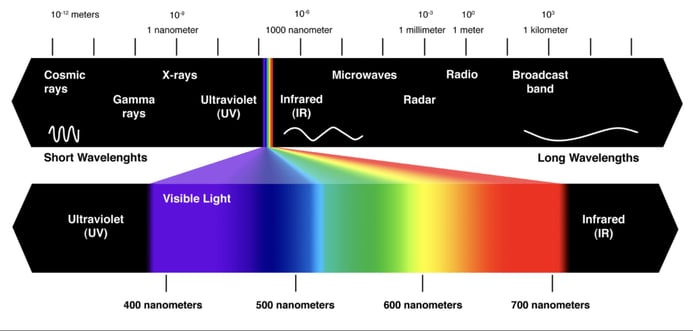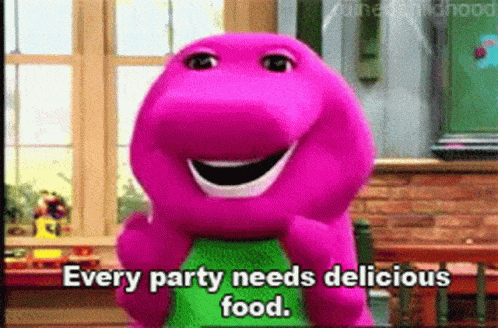
Posted on 02/03/2025 6:36:50 PM PST by Red Badger

There is something unique about the color purple: Our brain makes it up. So you might just call purple a pigment of our imagination.
It’s also a fascinating example of how the brain creates something beautiful when faced with a systems error.
To understand where purple comes from, we need to know how our eyes and brain work together to perceive color. And that all begins with light.
Light is another term for electromagnetic radiation. Most comes from the sun and travels to Earth in waves. There are many different types of light, which scientists group based on the lengths of those waves. (The wavelength is the distance between one wave peak and the next.) Together, all of those wavelengths make up the electromagnetic spectrum.
Our eyes can’t see most wavelengths, such as the microwaves used to cook food or the ultraviolet light that can burn our skin when we don’t wear sunscreen. We can directly see only a teeny, tiny sliver of the spectrum — just 0.0035 percent! This slice is known as the visible-light spectrum. It spans wavelengths between roughly 350 and 700 nanometers.
The acronym ROYGBIV (pronounced Roy-gee-biv) can be used to remember the order of colors in that visible spectrum: red, orange, yellow, green, blue, indigo and violet. You can see these colors in a rainbow stretching across the sky after a rainstorm or when light shines through a prism. In the visible spectrum, red light has the longest wavelength. Blue and violet are the shortest. Green and yellow sit toward the middle.
Although violet is in the visible spectrum, purple is not. Indeed, violet and purple are not the same color. They look similar, but the way our brain perceives them is very different.

How we see color
Color perception starts in our eyes. The backs of our eyes contain light-sensitive cells called cones. Most people have three types. They’re sometimes called red, green and blue cones because each is most sensitive to one of those colors.
But cones don’t “see” color, notes Zab Johnson. Instead, they detect certain wavelengths of light.
Johnson works at the University of Pennsylvania in Philadelphia. She and other scientists who study how we perceive color prefer to classify cones based on the range of wavelengths they detect: long, mid or short.
So-called red cones detect long wavelengths of light. Green cones respond most strongly to light in the middle of the visible spectrum. Blue cones best detect wavelengths toward the shorter end of the visible spectrum.
When light enters our eyes, the specific combination of cones it activates is like a code. Our brain deciphers that code and then translates it into a color.
Consider light that stimulates long- and mid-wavelength cones but few, if any, short-wavelength cones. Our brain interprets this as orange. When light triggers mostly short-wavelength cones, we see blue or violet. A combination of mid- and short-wavelength cones looks green. Any color within the visible rainbow can be created by a single wavelength of light stimulating a specific combination of cones.
:max_bytes(150000):strip_icc():format(webp)/the-visible-light-spectrum-2699036_FINAL2-c0b0ee6f82764efdb62a1af9b9525050.png)
Notice that the visible spectrum is a gradient. One color gradually shifts into the next. The activity of cones activated by the light also gradually shifts from one type to the next. At the red end of the spectrum, for instance, long-wavelength cones do most of the work. As you move from red to orange, the mid-wavelength cones help more and the long-wavelength cones do less.
In the middle of the rainbow — colors like green and yellow — the mid-wavelength cones are busiest, with help from both long- and short-wavelength cones. At the blue end of the spectrum, short-wavelength cones do most of the work.
But there is no color on the spectrum that’s created by combining long- and short-wavelength cones.
This makes purple a puzzle.
Purple is a mix of red (long) and blue (short) wavelengths. Seeing something that’s purple, such as eggplants or lilacs, stimulates both short- and long-wavelength cones. This confuses the brain. If long-wavelength cones are excited, the color should be red or near to that. If short-wavelength cones are excited, the color should be near to blue.
The problem: Those colors are on opposite ends of the spectrum. How can a color be close to both ends at once?
To cope, the brain improvises. It takes the visible spectrum — usually a straight line — and bends it into a circle. This puts blue and red next to each other.
“Blue and red should be on opposite ends of that linear scale,” Johnson explains. “Yet at some point, blue and red start to come together. And that coming-together point is called purple.”
Our brain now remodels the visible spectrum into a color wheel and pops in a palette of purples — which don’t exist — as a solution to why it’s receiving information from opposite ends of the visible spectrum.
Colors that are part of the visible spectrum are known as spectral colors. It only takes one wavelength of light for our brain to perceive shades of each color. Purple, however, is a nonspectral color. That means it’s made of two wavelengths of light (one long and one short).
This is the difference between violet and purple. Violet is a spectral color — part of the visible spectrum. Purple is a nonspectral color that the brain creates to make sense of confusing information.
Purple thus arises from a unique quirk of how we process light. And it’s a beautiful example of how our brains respond when faced with something out of the norm. But it’s not the only color that deserves our admiration, says Anya Hurlbert.
“All colors are made up by the brain. Full stop,” says this visual scientist at Newcastle University in England. They’re our brain’s way of interpreting signals from our eyes. And they add so much meaning to things we perceive, she says.
“The color of a bruise tells me how old it is. The color of a fruit tells me how ripe it is. The color of a piece of fabric tells me whether it’s been washed many times or it’s fresh off the factory line,” she says. “There’s almost nothing else that starts with something so simple [like a wavelength of light] and ends with something so deep and rich.”
It’s just a lighter shade of purple. In modern color theory, which is used in computer screens and printers, there are 6 main colors. Red, green, blue—and their opposites cyan, magenta, and yellow. Everything else is a combination of those. And if you combine them with white or black, you can control how light or dark they are.
There are many different single pigment reds, in paints.
There are many different single pigment blues, in paints.
Red and blue make purple, they can also make violet.
By adding quite a bit of water to a purple watercolor, you can easily make violet; however, you can NOT make violet into say a DIOXAZINE PURPLE. But....you certainly CAN make a violet shade ( by adding lots of water ) to a dioxazine purple!
OTOH...you can NOT make a COBALT VIOLET out of any old purple.

Purple
“Inside a color band are many different shades and violet IS a shade of PURPLE!”
Violet has its own part of the visible spectrum. Purple is a not part of that spectrum. It also has to have frequencies of red mixed in.
“...there is no color ON THE SPECTRUM that’s created by combining long- and short-wavelength cones.”
Purple is not a Spectral Color. Spectral Colors are single frequency/wavelength. Mixing different frequencies produces colors that are not in the spectrum, just like mixing different frequencies of sound produces melodious tones or screeches like fingernails on a chalkboard........
Written by someone who doesn’t understand Fourier analysis.
See #27
Can we just be happy that Purple exists as the lovely mystery (or not) that it is?
Violet is NOT a "color" per se; it is a SHADE of a color we call PURPLE.
Red, blue and yellow are "PRIMARY COLORS" and every single other "color" is a mix of those, and/or water content.
Oils, pastels, gouache, and dyes are the same, but sans the water.
But..........NO, magenta is only ONE shade that red and blue makes.
Magenta is far more red based ( with pink overtones ) than purple is. Magenta is a tertiary color.
“Nonsense.”
I’ll go one better - Balderdash!
People only exist in our minds. Yeah, sure. When we’re not looking at them, they don’t exist. They don’t affect the world at all.
“I paraphrased what was written, Mr. PICKY!”
That was your problem. You still get an F.
Again, you may know pigments but you know nothing about how the eye and brain process light.
“Red and blue make purple, they can also make violet.”
Again, you may know pigments but you know nothing about how the eye and brain process light.
Go learn some color theory. :-)
But DO allow ME to have mine.
And the picture of the color spectrum, used in the article, is PURPLE! Violet is a different shade. And this isn't a case of "a color by a different name" is that color.
“I paraphrased what was written, Mr. PICKY!”
That was your problem. You still get an F.
Again, you may know pigments but you know nothing about how the eye and brain process light.
“Red and blue make purple, they can also make violet.”
Again, you may know pigments but you know nothing about how the eye and brain process light.
Go watch some color mixing tutorials and learn something.
What’s a woman?
“And the picture of the color spectrum, used in the article, is PURPLE! Violet is a different shade.”
Violet is not a “shade” it has its own spectrum.
Purple is created by adding two parts of the visible spectrum.
Some people are colorblind, which, according to this article, means that their brains don't work right. Yes?
Disclaimer: Opinions posted on Free Republic are those of the individual posters and do not necessarily represent the opinion of Free Republic or its management. All materials posted herein are protected by copyright law and the exemption for fair use of copyrighted works.